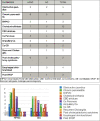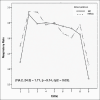Comparative evaluation of efficacy of oxygenation using high flow nasal cannula vs. conventional nasal cannula during procedural sedation for endoscopic ultrasound: A pilot study
- PMID: 35340968
- PMCID: PMC8944360
- DOI: 10.4103/joacp.JOACP_371_20
Comparative evaluation of efficacy of oxygenation using high flow nasal cannula vs. conventional nasal cannula during procedural sedation for endoscopic ultrasound: A pilot study
Abstract
Background and aims: High flow nasal cannula (HFNC) has numerous advantages against conventional oxygen therapy delivery systems. However, there is limited evidence supporting the use of HFNC in endoscopic ultrasound (EUS) under procedural sedation. The aims of this study is to evaluate the efficacy of two different oxygen delivery devices, that is,HFNCand conventional nasal cannula on the oxygenation status of patients during procedural sedation for EUS.
Material and methods: Sixty adult patients undergoing EUS for various ailments were randomized to two groups group HFNC (n=30) and group nasal cannula [NC (n = 30)]. HFNC (AIRVO2, Fisher and Paykel Healthcare, New Zealand) was used on patients in the group HFNC. Respiratory status of the patients was assessed using pulse oximetry, respiratory rate, procedural airway complications, and oxygen therapy adjustments. The endoscopist assessed the ease of performing EUS at the end of the procedure and patient satisfaction score (PSS) was assessed by using a Likert score in the post-anesthesia care unit.
Results: SpO2 measurements in the HFNC group during the procedure were marginally better compared to the NC group but this failed to reach statistical significance. Also, no significant association was found between both groups while comparing desaturation events (P = 0.499), patient satisfaction score (PSS) and endendoscopist's satisfaction score (ESS) (P = 0.795). Both the groups were comparable in terms of airway manipulation, use of airway adjuncts, need to increase oxygen flow rate, endoscope removal, apneic episodes, hypotension, and bradycardia. No major complications were observed in either group.
Conclusion: HFNC use in patients undergoing EUS is not superior when compared to conventional nasal cannula oxygen therapy. HFNC failed to show any significant impact on decreasing the risk of desaturation events and airway manipulation during the procedure.
Keywords: Cannula; endoscopy; endosonography; oxygen inhalation therapy; patient satisfaction.
Copyright: © 2022 Journal of Anaesthesiology Clinical Pharmacology.
Conflict of interest statement
There are no conflicts of interest.
Figures




Similar articles
-
Effect of High-Flow Nasal Cannula Oxygen Therapy on Pediatric Patients With Congenital Heart Disease in Procedural Sedation: A Prospective, Randomized Trial.J Cardiothorac Vasc Anesth. 2021 Oct;35(10):2913-2919. doi: 10.1053/j.jvca.2021.03.031. Epub 2021 Mar 27. J Cardiothorac Vasc Anesth. 2021. PMID: 33934982 Clinical Trial.
-
High-flow versus standard nasal cannula in morbidly obese patients during colonoscopy: A prospective, randomized clinical trial.J Clin Anesth. 2019 May;54:19-24. doi: 10.1016/j.jclinane.2018.10.026. Epub 2018 Nov 2. J Clin Anesth. 2019. PMID: 30391445 Clinical Trial.
-
High-flow nasal cannula versus standard low-flow nasal cannula during deep sedation in patients undergoing radiofrequency atrial fibrillation catheter ablation: a single-centre randomised controlled trial.Trials. 2022 May 9;23(1):378. doi: 10.1186/s13063-022-06362-1. Trials. 2022. PMID: 35534903 Free PMC article. Clinical Trial.
-
High-flow versus conventional nasal cannula oxygen supplementation therapy and risk of hypoxia in gastrointestinal endoscopies: a systematic review and meta-analysis.Expert Rev Respir Med. 2022 Mar;16(3):323-332. doi: 10.1080/17476348.2022.2042256. Epub 2022 Feb 22. Expert Rev Respir Med. 2022. PMID: 35157538
-
High flow nasal cannula for patients undergoing bronchoscopy and gastrointestinal endoscopy: A systematic review and meta-analysis.Front Surg. 2022 Aug 15;9:949614. doi: 10.3389/fsurg.2022.949614. eCollection 2022. Front Surg. 2022. PMID: 36046260 Free PMC article. Review.
Cited by
-
High-Flow Nasal Cannula Therapy as an Adjuvant Therapy for Respiratory Support during Endoscopic Techniques: A Narrative Review.J Clin Med. 2023 Dec 22;13(1):81. doi: 10.3390/jcm13010081. J Clin Med. 2023. PMID: 38202089 Free PMC article. Review.
-
A meta-analysis of the effects of transnasal high-flow oxygen therapy in gastrointestinal endoscopy.Front Med (Lausanne). 2024 Jun 27;11:1419635. doi: 10.3389/fmed.2024.1419635. eCollection 2024. Front Med (Lausanne). 2024. PMID: 38994339 Free PMC article.
References
-
- Yusoff IF, Raymond G, Sahai AV. Endoscopist administered propofol for upper-GI EUS is safe and effective:A prospective study in 500 patients. Gastrointest Endosc. 2004;60:356–60. - PubMed
-
- Berzin TM, Sanaka S, Barnett SR, Sundar E, Sepe PS, Jakubowski M, et al. A prospective assessment of sedation-related adverse events and patient and endoscopist satisfaction in ERCP with anesthesiologist-administered sedation. Gastrointest Endosc. 2011;73:710–7. - PubMed
-
- Ward JJ. High-flow oxygen administration by nasal cannula for adult and perinatal patients. Resp Care. 2013;58:98–122. - PubMed
LinkOut - more resources
Full Text Sources
